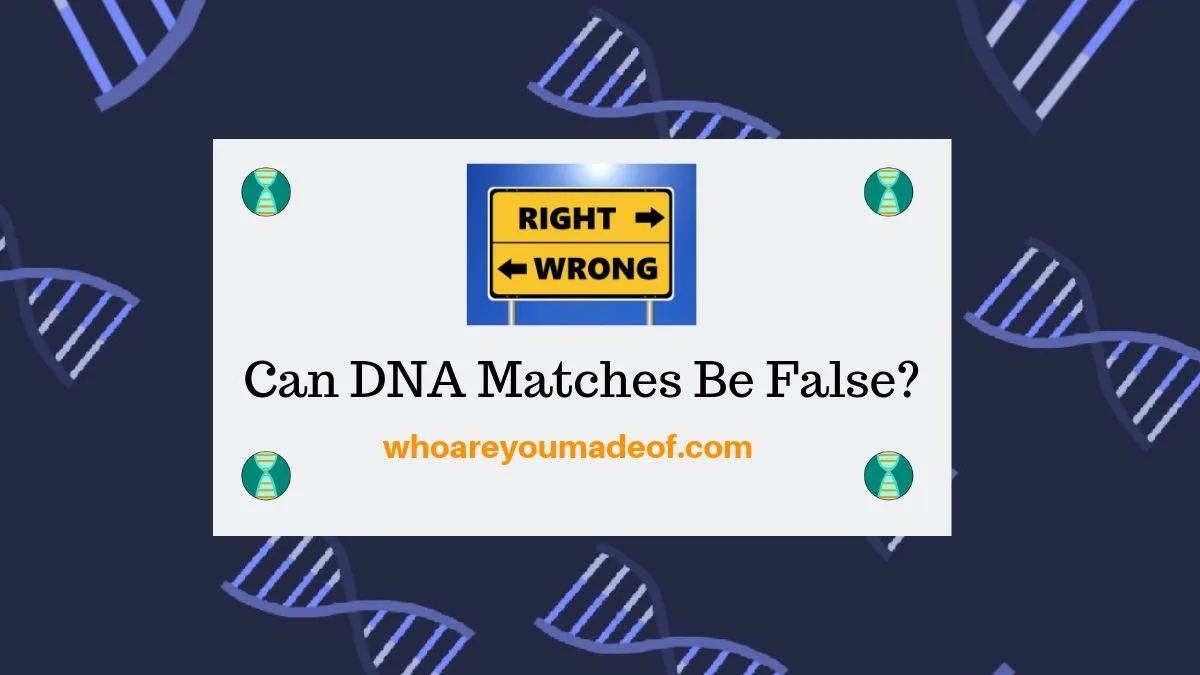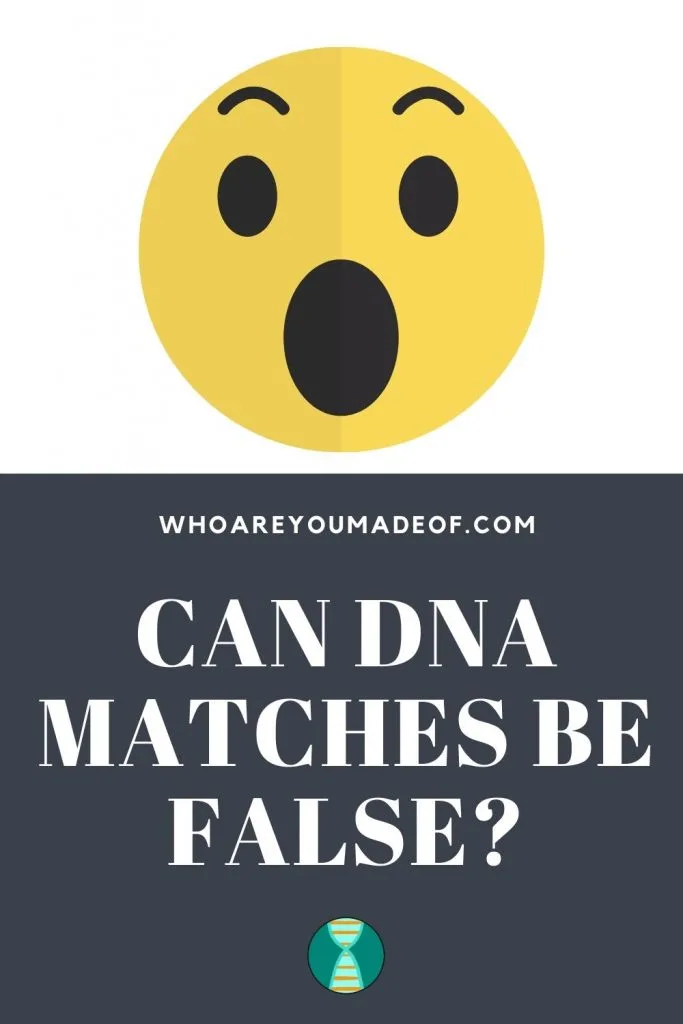Are you wondering if DNA matches can be false? What is the probability that your DNA match is false? In this post, I’ll answer these questions – and more!
Questions addressed in this article include:
- Can DNA matches be wrong?
- Are close DNA matches ever wrong?
- What are the odds that a DNA match is false?
- Which company has the most accurate DNA matches?

It’s important to know whether a DNA match is false. Have you ever spent hours trying to figure out how you are related to distant DNA match, only to eventually figure out that you probably aren’t really even related?
I have, and I want to save you some time.
Can DNA matches be wrong?
Yes, it is possible for distant DNA matches to be false. It is most common to have false DNA matches that share a single segment that is smaller than 10 centimorgans (cMs) in length.
It is important to note that a legitimate DNA match can also appear to be false based on not finding genealogical evidence of a connection.
DNA segments can get passed down for many, many generations. Many times, we might be related to DNA matches that appear to be false, but neither person has a family tree that is complete (or accurate) enough to be able to provide definitive proof that there is (or isn’t) a connection.
Or maybe you ARE related, but the link is maybe 16 generations back in your family tree – too far back to ever find the common ancestor?
If you have a false DNA match, it doesn’t mean that the testing company made a mistake. Instead, the DNA that you share with your DNA match is “coincidentally” identical.
The technical term for coincidentally identical DNA segments is identical-by-state. These segments are different than DNA segments that are identical because of common descent (identical-by-descent).
False positive DNA matches: What are the odds?
As I mentioned before, the odds that a DNA match is a false match increases with smaller DNA segments. This means that there is a low probability, or even almost zero probability, that larger segments are false.
For example:
- Segments over 15% have a 0% chance of being false (i.e. not inherited from mother or father)
Most segments between 10-15 cM are legitimate segments, inherited from a common ancestor. This common ancestor may be too far back to identify, however.
With smaller segments, we can see the odds of the match being false increase dramatically:
- Segments under 10 cM have about a 15% chance of being false (i.e. not inherited from mother or father)
- Segments under 5 cM have about an 85% chance of being false
Most experts in the genetic genealogy field recommend only focusing serious research on matches that share at least one segment that is larger than 10 cM in length. Just about every person who has done a DNA test should have many matches that match at this threshold, which should provide sufficient work and entertainment.
Close DNA matches are never false
I’m going to make a pretty bold statement:
Close DNA matches are basically never false.
DNA matches that are estimated to be related to us at a third cousin level or closer are most definitely related to us in some way. DNA testing companies use the amount of shared DNA that we have with our matches in order to estimate our relationship with our match.
You can use information like your family tree along with shared DNA to figure out the most likely connection with your match. This post can help you understand shared centimorgans and how to learn how you are related to your DNA matches:
The only exception to my “bold” general statement applies to people with substantial ancestry from endogamous populations, like Native American, French-Canadian, or Ashkenazi Jewish. DNA matches that fall into this category are not “false” matches, but are likely much more distantly related to you than is estimated.
If you think this might be the case with your “close” DNA matches, you can read this post:
How to know if you have false DNA matches
Have you ever heard someone say that it’s impossible to prove a negative?
When it comes to DNA segments, it’s very difficult to “prove” beyond doubt that there is no common ancestor at some point in history shared between two individuals.
Since when we talk about false DNA matches, we are referring to people who share only one or two very small DNA segments with us, it is unlikely that we can ever find compelling evidence to show that it is impossible that we are related.
Additionally, many of these smaller segments are impossible to trace. This means we can’t find compelling positive evidence of a connection.
How many of us have accurate, DNA verified family trees that go back 15-20 generations on all lines? No one has a tree like this, because it isn’t possible to verify DNA going back this many generations.
Which company has the most accurate DNA matches?
One of the most common questions that I receive in my inbox is whether it is possible to have false matches on Ancestry DNA. Others inquire as to which company provides the most accurate DNA matches.
The odds of finding false positive matches is just about the same on any DNA testing website. I think I get more e-mails about Ancestry DNA only because it’s the most popular DNA testing company.
This means that Ancestry DNA matches are just as accurate as matches that you will find on My Heritage, and vice versa. You won’t get more accurate matches on 23andMe than you will on Family Tree DNA.
The only slight difference that you will find across DNA testing companies is the “threshold” used to determine whether a person will show up on your list.
For example, some companies will only show you people who share with you segments that are longer than 10 cM. Other companies will show you people who only share 6 cM.
Still others might show you people who share as low as 4 cM with you as long as the total number of centimorgans shared reaches a different threshold.

Conclusion
I hope that this post has helped you understand more about false DNA matches, how common they are, and how to spot false DNA matches in your match list.
If you have any questions about something that you read in this post, or if you would like to share your own experience finding a false DNA match in your list, I would love for you to join us in the discussion below.
Thanks for stopping by today!


Ryan D
Monday 24th of April 2023
Is it possible that this match is identical by chance?
2 230767996 234702905 5.37 897 Half 10 69511110 73083467 6.03 1013 Half 10 130416520 133040379 8.28 826 Half
This person apparently doesn't match either of my parents, but we share three segments of over 5 cM in length.
What are the chances of that?
Sylvie Bouchard
Sunday 23rd of October 2022
Hi there I have a person that show that he is my husband half brother and also he has other relative that are close that are all first cousins from the same family on the father’s side… I did find my husband’s father and his supposed to be half brother has the same relatives in his match, so it showed to me they had the same father.I was able to find my husband half brother his mother since he was adopted at birth, his mother was telling him it was a different father for him and she didn’t know the person I had found to be their father when he talk to her about him. He took another test in a lab not a company between two sisters on his mother side to see if they were from the same father. With Ancestry one of her show half sister because the other sister didn’t take Ancestry DNA, but the lab results showed full sibling. So now he is saying my husband’s father is the same as his but my husband isn’t related to his sister on Ancestry they only share 30cM and his half brother share 2030cM with her. So there’s no way they share the same father. So what I am saying is that he doesn’t have the same father has his sisters but they are half sibling instead because they have the same mother. So I am wondering which test is wrong the Ancestry one or the lab one? The lab didn’t say how many cM they shared between them like Ancestry does, I believe more Ancestry because there’s lot of people that took it and it’s accurate. Can you explain to me how ge is my husband half brother on Ancestry and apparently not on a lab test.
Tate Rosethier
Wednesday 20th of April 2022
Thank you for this article. I was wondering if you had experience with false matches in the Scotch Irish of the southern United States?
I have many (at least 400) ancestry DNA matches that are clearly on my maternal side within this population (my father's people are very endogamous French/Scottish Canadians.)
This large group of mystery matches does not match my mother or her brother (though they do match with lots of other more distant matches from this side of the family.) The matches go all the way up to 35 cm in a single segment. I am lost as to how they can match up with my results but not my mother or her brother.
Thank you so much for your time and for the work that you do!
Stuart
Friday 3rd of September 2021
I was very pleased to read this article. Ancestry has thrown up a LOT of "matches" that made zero sense based on my family history. And the vast majority in this category are single segment matches with between 6 and 13 cM length.
Moreover since I have most of my direct lineage mapped and am more concerned with close relations to the lineage (my goal is not to build a catalogue of names!) I don't feel guilty now in discarding many of these as being co-incidental matches.
Other interesting things to note about DNA match reports for people you don't know by name ... the predicted relationship from the database (I used ancestry) may CHANGE as they reprocess data without you realizing it. Ancestry predicted one relative whose name I had NO CLUE as to identity (name change by 2nd marriage)! They suggested that she was my step sister or first cousin! WHAT????? By sheer coincidence, her brother died and I got an email telling me about the funeral (covidized) that had her on the distribution list. I sent an email to the sender (cousin removed) and bingo discovered who she was ... 2nd cousin ... went back to Ancestry a few weeks later and lo and behold ... re-evaluated to 2nd cousin!
I put my foot in my mouth 3 times in trying to work out who she was in the process.
Nam McDonald
Friday 3rd of September 2021
Hello, I have the following results with what I thought was my first cousin: 27% shared DNA: 1,894 cM across 53 segments
I share no where near this amount with any of my other first cousins!
So, is this a cousin or a half-sibling! They will not communicate with me & used a false name for identification. I am puzzled!
Stuart
Friday 3rd of September 2021
@Nam McDonald, It happens. I have a first cousin who conversely has a very LOW shared DNA that Ancestry suggests 2nd cousin ... but that's not possible because of the age ladder and HER children are the expected amount.
Why? I don't know.